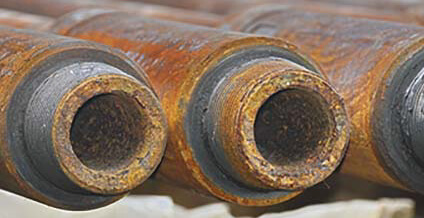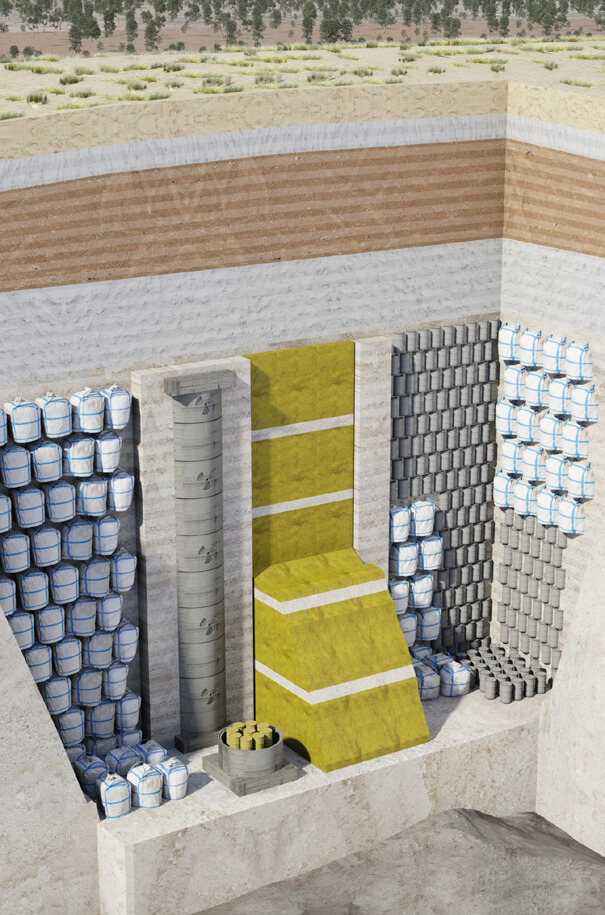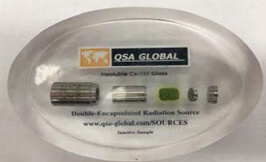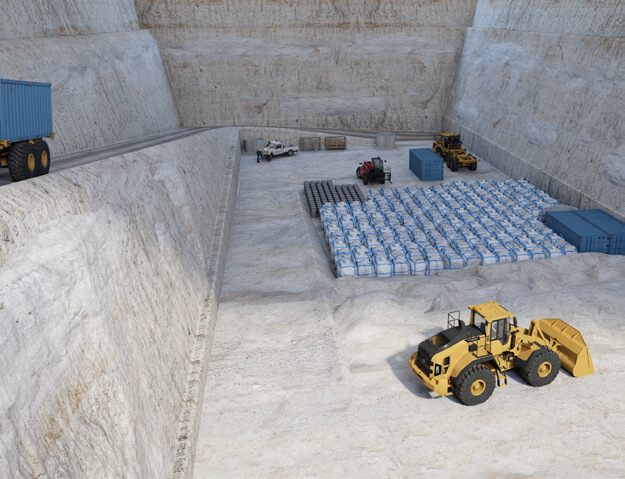PERMANENT ISOLATION OF RADIOACTIVE WASTE USING GEOLOGICAL REPOSITORIES
Permanent Isolation (Disposal) of Low Level Radioactive Waste (LLW)
Low level radioactive waste (LLW) is any radioactive waste requiring robust isolation and containment for an extended period. This can include naturally occurring radioactive material (NORM) or disused sealed radioactive sources (DSRS).
Techniques for managing LLW have typically been very limited in Australia and have included:
- Surface and temporary storage for extended time periods, which increases the risk of radionuclide release and/or exposure.
- Export for disposal to an international facility. International transport is heavily regulated, higher risk and is often cost prohibitive.
- Return of DSRS to the manufacturer, provided the company still exists and is willing to accept the source and if the appropriate international and national approvals can be obtained.
- Disposal at Mt Walton East IWDF which operates on a campaign basis and only accepts waste generated in Western Australia.
NATURALLY OCCURRING RADIOACTIVE MATERIAL
NORM is the term used to describe material that contains radionuclides from the natural environment. Although the radionuclide content is low in most environments, the processing of materials extracted from the earth (e.g. mineral sands or hydrocarbons) can concentrate the NORM. Typical waste streams may be contaminated soils, sludges and scales deposited in processing equipment (e.g. pipes, Fig. 1).
NORM does not pose the same level of external radiation risk as DSRS but does pose a significant internal hazard both from inhalation of dust as well as potential for exposure to radon gas due to radium decay. Therefore, NORM has the potential to harm humans and the environment and must be managed appropriately.
Fig. 1: Build-up of NORM contaminated scale in a pipes

Fig. 2: Conceptual waste placement

IMMOBILISATION AND DISPOSAL OF NORM CONTAMINATED WASTES
Tellus intends to dispose NORM contaminated waste in accordance with best practices described by the International Atomic Energy Agency (IAEA), particularly Safety Requirements for the Disposal of Radioactive Waste (SSR-5).
SSR-5 requires that the facility design includes barriers to prevent or minimise the release of radionuclides. Therefore, Tellus must immobilise some wastes prior to disposal in a low-permeability clay bed.
Immobilisation treatment involves locking the waste into a cementitious matrix and/or adsorbing it into a suitable material. NORM wastes that do not require immobilisation, such as contaminated equipment, will be disposed according to the appropriate procedure, which may include grouting of any void spaces in equipment pieces (e.g. pipes).
TELLUS WASTE ACCEPTANCE CRITERIA
Tellus intends to accept LLW at the Sandy Ridge Facility and has developed management techniques in order to account for the varying characteristics of NORM, DSRS and other LLW.
UNACCEPTABLE WASTE
- Sandy Ridge Facility will not accept nuclear waste, in accordance with the Nuclear Waste Storage and Transportation (Prohibition) Act 1999 (WA).
- Intermediate Level Waste (ILW) and High Level Waste (HLW) radioactive waste such as reprocessed spent nuclear fuel and materials with high levels of radioactivity.
SEALED RADIOACTIVE SOURCES
Sealed radioactive sources (SRS) consist of concentrated radioactive material that is sealed within a protective container (Fig. 3). They are typically small, but much higher in activity than NORM wastes.
SRS are used in numerous industries, including mining, medicine, oil and gas production, agriculture, education, and research. Over time, the sealed source decays and becomes less radioactive. Eventually it reaches a point where it can no longer be used for its intended purpose, but is still radioactive enough to potentially harm humans and the environment.
DISPOSAL OF DISUSED SEALED SOURCES
Tellus intends to dispose of DSRS via specially constructed concrete shafts within the facility waste cells. This method uses the passive safety of the kaolin clay to permanently isolate DSRS from the biosphere.
STEPS INVOLVED
1. DSRS conditioning
Placement of disused sealed sources into a lead capsule and a Type A package for safe handling and transport.
2. Transport and delivery
The packaged capsules are transported to the Sandy Ridge Facility in accordance with the relevant regulations.
3. Arrival and acceptance
Capsules will be subject to verification testing to confirm acceptability for disposal. Accepted capsules will be concreted into a drum to form the final disposal package.
4. Disposal
Disposal packages will be placed within the concrete shaft, each layer of drums will be separated by concrete. The shaft will be sealed with a final cap of concrete to maintain long-term safety.
Fig. 3: An inactive sample of a sealed source

THE TELLUS SOLUTION
Tellus is currently developing storage, recovery, and permanent isolation infrastructure in the form of geological repository facilities supported by a “hub and spoke” logistics solution across Australia.

KEY CLIENT BENEFITS
Tellus offers simple, safe and cost-effective storage, treatment and permanent isolation (disposal) solutions for hazardous wastes.
Features and benefits include:
| Quality |
|
| Commercial and risk transfer |
|
| Functionality |
|
| Sandy Ridge availability and innovation |
|
| Regulatory approvals and licensing |
|
| Price |
|
